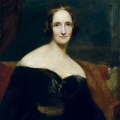 Mary Shelley was an English novelist, short story writer, dramatist, essayist, biographer, and travel write. She was born on August 13th, 1797, and is best known for her Gothic novel Frankenstein: or, The Modern Prometheus (1818). She also edited and promoted the works of her husband, the Romantic poet and philosopher Percy Bysshe Shelley. Her father was the political philosopher William Godwin, and her mother was the philosopher and feminist Mary Wollstonecraft.
Mary Shelley was an English novelist, short story writer, dramatist, essayist, biographer, and travel write. She was born on August 13th, 1797, and is best known for her Gothic novel Frankenstein: or, The Modern Prometheus (1818). She also edited and promoted the works of her husband, the Romantic poet and philosopher Percy Bysshe Shelley. Her father was the political philosopher William Godwin, and her mother was the philosopher and feminist Mary Wollstonecraft.
After their mother's death, Mary and her older half-sister, Fanny Imlay, were reared by their father. When Mary was four, Godwin married his neighbour, Mary Jane Clairmont. Godwin provided his daughter with a rich, if informal, education, encouraging her to adhere to his liberal political theories. In 1814, Mary Godwin began a romantic relationship with one of her father’s political followers, the married Percy Bysshe Shelley. Together with Mary's stepsister, Claire Clairmont, they left for France and travelled through Europe. When they returned to England, Mary was pregnant with Percy's child. Over the next two years, she and Percy faced ostracism, constant debt, and the death of their prematurely born daughter. They married in late 1816 after the suicide of Percy Shelley's first wife, Harriet.
In 1816, the couple famously spent a summer with Lord Byron, John William Polidori, and Claire Clairmont near Geneva, Switzerland, where Mary conceived the idea for her novel Frankenstein. By the time she was nineteen, Mary Wollstonecraft Shelley had written one of the most famous novels ever published. Embodying one of the central myths of Western culture, Frankenstein; or, The Modern Prometheus, first published in 1818, tells the story of an overreacher who brings to life the monster who inhabits one's dreams, a tale which still stands as a powerful and enduring example of the creative imagination.
The family left Britain in 1818 for Italy, where their second and third children died before Mary Shelley gave birth to her last and only surviving child, Percy Florence Shelley. In 1822, her husband drowned when his sailing boat sank during a storm near Viareggio. A year later, Mary Shelley returned to England and from then on devoted herself to the upbringing of her son and a career as a professional author. The last decade of her life was dogged by illness, probably caused by the brain tumor that was to kill her at the age of 53 on February first, 1851.
Until the 1970s, Mary Shelley was known mainly for her efforts to publish her husband's works and for her novel Frankenstein. Nearly two hundred years later, the story of his creation still inspires stage, film, video, and television productions. In addition to this novel, Mary Shelley wrote six other novels, a novella, mythological dramas, stories and articles, various travel books, and biographical studies. Recently scholars have shown increasing interest in her other literary output, particularly in her novels, which include the historical novels Valperga (1823) and Perkin Warbeck (1830), the apocalyptic novel The Last Man (1826), and her final two novels, Lodore (1835) and Falkner (1837).
Nazira Artykbayeva, Librarian of the International Book Department.

